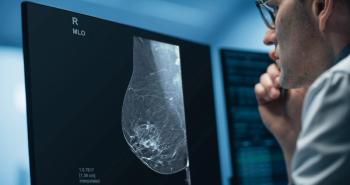
MRI tops CT at detecting intraductal breast cancer
MRI is better than multislice CT for determining if and how far breast cancer has spread into the breast ducts, and it should be used before patients receive breast conserving therapy, according to a study in the August issue of the American Journal of Roentgenology.
MRI is better than multislice CT for determining if and how far breast cancer has spread into the breast ducts, and it should be used before patients receive breast conserving therapy, according to a study in the August issue of the American Journal of Roentgenology.
Breast conserving therapy is prevalent for the treatment of early stage breast cancers. Among patients who receive such therapy, however, the overall survival rate is significantly lower when surgical margins are positive for tumor cells than when they are negative.
A positive surgical margin is usually the result of inadequate resection of the cancer's intraductal component. Accurate preoperative diagnosis of the intraductal component is therefore crucial to achieving a cancer-free surgical margin, according to the study.
Earlier studies that determined CT can accurately assess the extent of breast cancer are now being called into question because they compared single-slice spiral CT with 0.5T MRI. Some recent studies suggest that MSCT could be used to distinguish benign lesions from carcinomas, but these reports did not evaluate the extent of the involvement of intraductal components.
Dr. Akiko Shimauchi, a graduate student at Tohoku University in Japan at the time of the study in AJR, and colleagues retrospectively reviewed reports of 69 patients with histologically proven invasive carcinoma who underwent MSCT and MRI. CT scans were performned on a LightSpeed Qx/i from GE Healthcare. MRI was performed using a 1.5T Magnetom Vision from Siemens Medical Solutions.
The 44 cases with intraductal component enhancement were classified into two morphologic types: ductal extension (34) and segmental distribution (10). The lengths of the main tumor and of the intraductal component were measured in cases with ductal extension. For cases with segmental distribution, only the maximum length of the tumor was measured.
MRI correctly identified 33 of the 44 cases, while MSCT correctly identified 27. In six cases, MRI revealed an intraductal component but MSCT did not, but in no cases did MSCT reveal an intraductal component that was undetectable with MRI.
The sensitivity, specificity, and accuracy in detecting the intraductal component were 61%, 88%, and 71%, respectively, using MSCT and 75%, 88%, and 80%, respectively, using MRI. The difference in sensitivity between MRI and CT was significant.
Underestimation of the length of the intraductal components by 15 mm or more was significantly less frequent with MRI (30%) compared with MSCT (55%).
No significant difference between MSCT and MRI occurred in the evaluation of the maximum length of tumors in cases with segmental distribution, which had relatively large intraductal components.
"In our institution, surgeons err on the side of caution by using a surgical margin that is 20 mm outside the radiologically determined tumor margin," Shimauchi said.
The most undesirable feature of MSCT is exposure to radiation, according to the authors. The dose of radiation at the skin surface for the acquisition of an MSCT image during a single breath-hold was 26 mGy, which is almost equivalent to the dose reported for conventional CT.
The safety of the exposure of the contralateral breast to radiation during CT has not been verified. This could limit the repeat scanning of the breast that would be possible with MRI, which could improve the depiction of the intraductal component.
Advantages of breast MSCT over MRI include a faster scanning speed, availability of the supine position (which allows surgical simulation), and simultaneous scanning of both breasts (which allows the affected breast to be compared with the contralateral breast).
For more information from the Diagnostic Imaging archives:
Newsletter
Stay at the forefront of radiology with the Diagnostic Imaging newsletter, delivering the latest news, clinical insights, and imaging advancements for today’s radiologists.




























